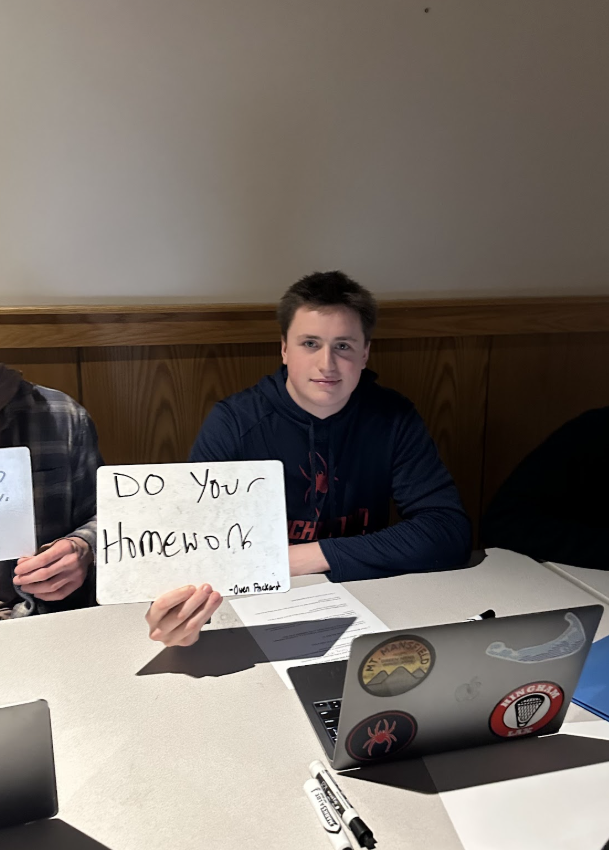The Local Heroin Crisis-An Interview with a First Responder
Photo courtesy of the Avitabile family for hereandnow.wbur.org
Patrick Avitabile (left) and James Avitabile (right) are pictured with their father Louis Avitabile (center). Patrick died of an overdose in August 2015; James died of an overdose in July 2013.
March 3, 2016
There is an epidemic in New England that reaches from smaller rural towns in New Hampshire and Vermont to larger cities such as Portland, Maine, as well as Brockton and Quincy, Massachusetts. This epidemic is heroin addiction. Heroin is a highly addictive drug that is affecting people of all classes and races.
Heroin, a drug popular in the 1990’s, has undergone a massive resurgence in popularity across the United States, but especially in the towns and cities of New England due to its cheap cost and availability compared to prescription pills. The fact that heroin is extremely addictive has caused the drug to impact communities throughout New England.
Boston EMS EMT Rob Stearns admitted that the crisis has taken center stage in Boston. Stearns works at A10, one of the busiest ambulance stations in the city; it covers parts of South Boston and Roxbury. Like the rest of New England, Boston has seen a massive spike in overdose related deaths over the last couple years. In 2012 the city experienced 62 opioid related overdose deaths but saw a substantial increase to 87 in 2014.
The risk of fatal overdose is a major worry for the families of heroin addicts, who are understandably concerned for the lives of their children. Since the drug is extremely addictive, a drug user’s dependency increases over time to achieve the desired effect or “high.” This increased tolerance to the effects of heroin increases the danger of overdose, as the increasing dosage brings greater risk. Heroin users also face many challenges when trying to detox or get “clean,” as there are few treatment centers for addiction and long wait lists to get in these clinics. These issues taken together challenge not just the drug users, but the families of addicts dealing with the impact of addiction.
As far as demographics go, Stearn said “I can tell you that we treat patients of all ages who have overdosed. The youngest patient I remember treating was 18 years old and the oldest was in her 70s. We’ve revived folks on the street, under bridges, and in downtown high-rise luxury condominiums that overlook the water.”
An effective way to treat heroin overdoses is Naloxone, more commonly known as Narcan. However, due to an increased need of this drug by first responders, drug companies have attempted to raise the cost in order to increase profits. This corporate greed prevents more widespread access to the lifesaving drug for the public. This practice of price gouging has prompted several requests to the state legislature across New England to make the drug a set cost.
Most heroin addiction is caused by increased prescription of highly potent painkillers, such as Oxycodone and Vicodin, in most cases after a serious injury. These prescription pills are highly addictive. Often times these patients switch from prescription pills to heroin because it is cheaper. Also, since many users often abuse multiple drugs with heroin, the dangers of overdose are even higher.
In overdose emergencies, Stearns said, “Our initial evaluation includes assessing mental status and oxygenation. Not every overdose requires administration of Narcan. Often times… supplemental O2 and verbal stimulation is all that is required. When a patient’s respiratory drive is so compromised that we must administer Narcan, we are careful to oxygenate the patient first, so that they don’t “wake up” with a hypoxic brain. When someone’s respiratory drive is diminished by an opiate, their brain becomes “cranky’ because it is starved of oxygen. We want to ensure the patient gets some 02 up to his brain prior to waking that brain.”
Stearns added “if we don’t the patient can become violent once the Narcan kicks in. Narcan often takes a while to work. After we… maintain their airway, we bag him/her up…for as long as it takes to get their O2 saturation up…we administer Narcan…We resume assisting their breathing until they regain consciousness. Oftentimes, because the addict’s body is used to a certain level of opiates in their system at all times, the patient is forced into withdrawal with the Narcan… and they become quite ill…and we need to be careful to protect their airway when this happens.”
The opioid crisis extends to towns and cities, both small in large. Many communities have families who have lost a loved one due to this epidemic. The numbers reach an alarming rate, and the opioid crisis has taken the lives of more people than motor vehicle accidents in Massachusetts. Two thousand motor vehicle accidents claimed lives of 328 Massachusetts citizens in 2014, but in the same year there were 1173 opioid related overdoses.
Stearns hopes an increased awareness will lower the number of deaths. “It seems most of what we hear in the news regarding ODs includes only the fatal ones,” he said, “but there are so, so many patients who do not die because of outside intervention, whether it be family/friend administration of Narcan… or our intervention, or some combination thereof.”
































